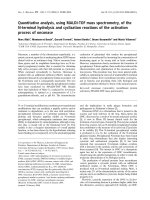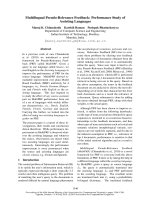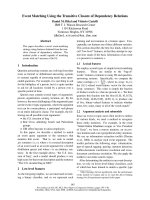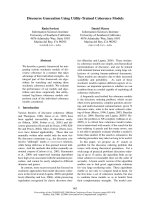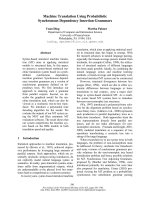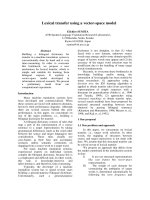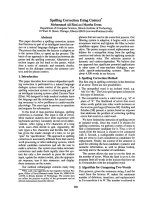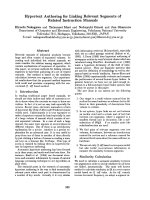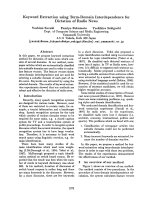Báo cáo khoa học: "Multilingual authoring using feedback texts" pdf
Bạn đang xem bản rút gọn của tài liệu. Xem và tải ngay bản đầy đủ của tài liệu tại đây (597.63 KB, 7 trang )
Multilingual authoring using feedback texts
Richard Power and Donia Scott
ITRI, University of Brighton
Lewes Road, Brighton BN2 4AT, UK
Abstract
There are obvious reasons for trying to auto-
mate the production of multilingual documen-
tation, especially for routine subject-matter in
restricted domains (e.g. technical instructions).
Two approaches have been adopted: Machine
Translation (MT) of a source text, and Multi-
lingual Natural Language Generation (M-NLG)
from a knowledge base. For MT, information
extraction is a major difficulty, since the mean-
ing must be derived by analysis of the source
text; M-NLG avoids this difficulty but seems
at first sight to require an expensive phase of
knowledge engineering in order to encode the
meaning. We introduce here a new technique
which employs M-NLG during the phase of
knowledge editing. A 'feedback text', generated
from a possibly incomplete knowledge base, de-
scribes in natural language the knowledge en-
coded so far, and the options for extending it.
This method allows anyone speaking one of the
supported languages to produce texts in all of
them, requiring from the author only expertise
in the subject-matter, not expertise in knowl-
edge engineering.
1 Introduction
The production of multilingual documentation
has an obvious practical importance. Compa-
nies seeking global markets for their products
must provide instructions or other reference ma-
terials in a variety of languages. Large politi-
cal organizations like the European Union are
under pressure to provide multilingual versions
of official documents, especially when communi-
cating with the public. This need is met mostly
by human translation: an author produces
a
source document which is passed to a number
of other people for translation into other lan-
guages.
Human translation has several well-known
disadvantages. It is not only costly but time-
consuming, often delaying the release of the
product in some markets; also the quality is un-
even and hard to control (Hartley and Paris,
1997). For all these reasons, the production of
multilingual documentation is an obvious can-
didate for automation, at least for some classes
of document. Nobody expects that automation
will be applied in the foreseeable future for liter-
ary texts ranging over wide domains (e.g. nov-
els). However, there is a mass of non-literary
material in restricted domains for which au-
tomation is already a realistic aim: instructions
for using equipment are a good example.
The most direct attempt to automize multi-
lingual document production is to replace the
human translator by a machine. The source is
still
a natural language document written by a
human author; a program takes this source as
input, and produces an equivalent text in an-
other language as output. Machine translation
has proved useful as a way of conveying roughly
the information expressed by the source, but the
output texts are typically poor and over-literal.
The basic problem lies in the analysis phase: the
program cannot extract from the source all the
information that it needs in order to produce a
good output text. This may happen either be-
cause the source is itself poor (e.g. ambiguous
or incomplete), or because the source uses con-
structions and concepts that lie outside the pro-
gram's range. Such problems can be alleviated
to some extent by constraining the source doc-
ument, e.g. through use of a 'Controlled Lan-
guage' such as AECMA (1995).
An alternative approach to translation is that
of generating the multilingual documents from
a non-linguistic source. In the case of automatic
Multilingual Natural Language Generation (M-
1053
NLG), the source will be a knowledge base ex-
pressed in a formal language. By eliminating
the analysis phase of MT, M-NLG can yield
high-quality output texts, free from the 'literal'
quality that so often arises from structural imi-
tation of an input text. Unfortunately, this ben-
efit is gained at the cost of a huge increase in the
difficulty of obtaining the source. No longer can
the domain expert author the document directly
by writing a text in natural language. Defining
the source becomes a task akin to building an
expert system, requiring collaboration between
a domain expert (who understands the subject-
matter of the document) and a knowledge engi-
neer (who understands the knowledge represen-
tation formalism). Owing to this cost, M-NLG
has been applied mainly in contexts where the
knowledge base is already available, having been
created for another purpose (Iordanskaja et al.,
1992; Goldberg et al., 1994); for discussion see
Reiter and Mellish (1993).
Is there any way in which a domain expert
might author a knowledge base without going
through this time-consuming and costly collab-
oration with a knowledge engineer? Assum-
ing that some kind of mediation is needed be-
tween domain expert and knowledge formalism,
the only alternative is to provide easier tools
for editing knowledge bases. Some knowledge
management projects have experimented with
graphical presentations which allow editing by
direct manipulation, so that there is no need to
learn the syntax of a programming language -
see for example Skuce and Lethbridge (1995).
This approach has also been adopted in two
M-NLG systems: GIST (Power and Cavallotto,
1996), which generates social security forms in
English, Italian and German; and
DRAFTER
(Paris et al., 1995), which generates instructions
for software applications in English and French.
These projects were the first attempts to pro-
duce
symbolic authoring
systems - that is, sys-
tems allowing a domain expert with no training
in knowledge engineering to author a knowledge
base (or
symbolic source)
from which texts in
many languages can be generated.
Although helpful, graphical tools for manag-
ing knowledge bases remain at best a compro-
mise solution. Diagrams may be easier to un-
derstand than logical formalisms, but they still
lack the flexibility and familiarity of natural lan-
guage text, as empirical studies on editing di-
agrammatic representations have shown (Kim,
1990; Petre, 1995); for discussion see Power et
al. (1998). This observation has led us to ex-
plore a new possibility, at first sight paradoxical:
that of a symbolic authoring system in which
the current knowledge base is presented through
a natural language text
generated by the system.
This kills two birds with one stone: the source is
still a knowledge base, not a text, so no problem
of analysis arises; but this source is presented to
the author in natural language, through what
we will call a
feedback text.
As we shall see, the
feedback text has some special features which
allow the author to edit the knowledge base as
well as viewing its contents. We have called this
editing method
'WYSIWYM', or
'What You See
Is What You Meant': a natural language text
('what you see') presents a knowledge base that
the author has built by purely semantic deci-
sions ('what you meant').
A basic WYSIWYM system has three compo-
nents:
• A module for building and maintaining
knowledge bases. This includes a 'T-Box'
(or 'terminology'), which defines the con-
cepts and relations from which assertions
in the knowledge base (or 'A-Box') will be
formed.
• Natural language generators for the lan-
guages supported by the system. As well
as producing output texts from complete
knowledge bases, these generators will pro-
duce feedback texts from knowledge bases
in any state of completion.
• A user interface which presents output or
feedback texts to the author. The feedback
texts will include mouse-sensitive 'anchors'
allowing the author to make semantic deci-
sions, e.g. by selecting options from pop-up
menus.
The WYSIWYM system allows a domain expert
speaking any
one
of the supported languages to
produce good output texts in
all
of them. A
more detailed description of the architecture is
given in Scott et al. (1998).
2 Example of a WYSIWYM system
The first application of WYSIWYM was
DRAFTER-II,
a system which generates in-
1054
stuctions for using word processors and diary
managers. At present three languages are
supported: English, French and Italian. As an
example, we will follow a session in which the
author encodes instructions for scheduling an
appointment with the OpenWindows Calendar
Manager. The desired content is shown by the
following output text, which the system will
generate when the knowledge base is complete:
To schedule the
appointment:
Before starting, open the Appoint-
ment Editor window by choosing the
Appointment option from the Edit
menu.
Then proceed as follows:
1 Choose the start time of the ap-
pointment.
2 Enter the description of the ap-
pointment in the What field.
3 Click on the Insert button.
In outline, the knowledge base underlying this
text is as follows. The whole instruction is rep-
resented by a procedure instance with two at-
tributes: a goal (scheduling the appointment)
and a method. The method instance also has two
attributes: a precondition (expressed by the
sentence beginning 'Before starting') and a se-
quence of steps (presented by the enumerated
list). Preconditions and steps are procedures in
their turn, so they may have methods as well as
goals. Eventually we arrive at sub-procedures
for which no method is specified: it is assumed
that the reader of the manual will be able to
click on the Insert button without being told
how.
Since in DRAFTER-II every output text is
based on a procedure, a newly initialised knowl-
edge base is seeded with a single procedure in-
stance for which the goal and method are unde-
fined. In Prolog notation, we can represent such
a knowledge base by the following assertions:
procedure(procl).
goal(procl, A).
method(procl,
B).
Here procl is an identifier for the procedure in-
stance; the assertion procedure (procl) means
that this is an instance of type procedure;
and the assertion goal(procl, A) means that
procl
has a goal attribute for which the value
is currently undefined (hence the variable A).
When a new knowledge base is created,
DRAFTER-II presents it to the author by gen-
erating a feedback text in the currently selected
language. Assuming that this language is En-
glish, the instruction to the generator will be
generate(procl, english,
feedback)
and the feedback text displayed to the author
will be
Achieve this goal by applying this
method.
This text has several special features.
• Undefined attributes are shown through
anchors in bold face or italics. (The system
actually uses a colour code: red instead of
bold face, and green instead of italics.)
• A red anchor (bold face) indicates that the
attribute is obligatory: its value must be
specified. A green anchor (italics) indicates
that the attribute is optional.
• All anchors are mouse-sensitive. By click-
ing on an anchor, the author obtains a pop-
up menu listing the permissible values of
the attribute; by selecting one of these op-
tions, the author updates the knowledge
base.
Although the anchors may be tackled in any
order, we will assume that the author proceeds
from left to right. Clicking on this goal yields
the pop-up menu
choose
click
close
create
save
schedule
start
(to save space, this figure omits some options),
from which the author selects 'schedule'. Each
option in the menu is associated with an 'up-
dater', a Prolog term (not shown to the author)
that specifies how the knowledge base should be
updated if the option is selected. In this case the
updater is
1055
insert(procl, goal, schedule)
meaning that an instance of type schedule
should become the value of the goal attribute
on procl. Running the updater yields an ex-
tended knowledge base, including a new in-
stance schedl with an undefined attribute
actee. (Assertions describing attribute values
are indented to make the knowledge base easier
to read.)
procedure (proc 1).
goal(procl, schedl).
schedule (schedl).
actee(schedl, C).
method(procl, B).
From the updated knowledge base, the genera-
tor produces a new feedback text.
Schedule this event by applying this
method.
Note that this text has been completely regen-
erated. It was not produced from the previous
text merely by replacing the anchor this goal
by a longer string.
Continuing to specify the goal, the author
now clicks on this event.
appointment
meeting
This time the intended selection is 'appoint-
ment', but let us assume that by mistake the au-
thor drags the mouse too far and selects 'meet-
ing'. The feedback text
Schedule the meeting by applying this
method.
immediately shows that an error has been made,
but how can it be corrected? This problem is
solved in WYSIWYM by allowing the author to
select any span of the feedback text that repre-
sents an attribute with a specified value, and to
cut it, so that the attribute becomes undefined,
while its previous value is held in a buffer. Even
large spans, representing complex attribute val-
ues, can be treated in this way, so that complex
chunks of knowledge can be copied across from
one knowledge base to another. When the au-
thor selects the phrase 'the meeting', the system
displays a pop-up menu with two options:
By selecting 'Cut', the author activates the up-
dater
cut(schedl, actee)
which updates the knowledge base by removing
the instance meetl, currently the value of the
actee attribute on schedl, and holding it in a
buffer. With this attribute now undefined, the
feedback text reverts to
Schedule this event by applying this
method.
whereupon the author can once again expand
this event. This time, however, the pop-up
menu that opens on this anchor will include an
extra option: that of pasting back the material
that has just been cut. Of course this option is
only provided if the instance currently held in
the buffer is a suitable value for the attribute
represented by the anchor.
Paste
appointment
meeting
The 'Paste' option here will be associated with
the updater
paste(schedl, actee)
which would assign the instance currently in the
buffer, in this case meetl, as the value of the
actee attribute on schedl. Fortunately the au-
thor avoids reinstating this error, and selects
'appointment', yielding the following reassuring
feedback text:
Schedule the appointment by applying
this method.
Note incidentally that this text presents a
knowledge base that is potentially complete,
since all obligatory attributes have been spec-
ified. This can be immediately seen from the
absence of any red (bold) anchors.
Intending to add a method, the author now
clicks on this method. In this case, the pop-up
menu shows only one option:
[ method ]
1056
Running the associated updater yields the fol-
lowing knowledge base:
procedure(procl).
goal(procl, schedl).
schedule(schedl).
actee(schedl,
apptl).
appointment(apptl).
method(procl, methodl).
method(methodl).
precondit±on(methodl,
D).
steps(methodl,
stepsl).
steps(stepsl).
first(stepsl, proc2).
procedure(proc2).
goal(proc2, F).
method(proc2, G).
rest(stepsl, E).
meeting(meetl).
A considerable expansion has taken place here
because the system has been configured to auto-
matically instantiate obligatory attributes that
have only one permissible type of value. (In
other words, it never presents red anchors with
pop-up menus having only one option.) Since
the steps attribute on methodl is obligatory,
and must have a value of type steps, the in-
stance stepsl is immediately created. In its
turn, this instance has the attributes first and
rest (it is a list), where first is obligatory and
must be filled by a procedure. A second proce-
dure instance proc2 is therefore created, with
its own goal and method. To incorporate all
this new material, the feedback text is recast in
a new pattern, the main goal being expressed
by an infinitive construction instead of an im-
perative:
To schedule the appointment:
First, achieve this precondition.
Then follow these steps.
1 Perform this action by applying
this method.
2 More steps.
Note that at any stage the author can switch
to one of the other supported languages, e.g.
French. This will result in a new call to the
generator
generate(procl, french, feedback)
and hence in a new feedback text expressing the
procedure proc 1.
Insertion du rendez-vous:
Avant de commencer, accomplir cette
tdche.
Ex~cuter les actions suivantes.
1 Ex~cuter cette action en appli-
quant cette mdthode.
2 Autres sous-actions.
Clicking for example on cette action will now
yield the usual options for instanciating a goal
attribute, but expressed in French. The asso-
ciated updaters are identical to those for the
corresponding menu in English.
choix
cliquer
fermer
,.°°,
enregistrement
insertion
lancement
The basic mechanism should now be clear,
so let us advance to a later stage in which the
scheduling procedure has been fully encoded.
To schedule the appointment:
First, open the Appointment Editor
window.
Then follow these steps.
1 Choose the start time of the
appointment by applying this
method.
2 Enter the description of the ap-
pointment in the What field by ap-
plying this method.
3 Click on the Insert button by ap-
plying this method.
4 More steps.
To open the Appointment Editor win-
dow:
First, achieve this precondition.
Then follow these steps.
1 Choose the Appointment option
from the Edit menu by applying
this method.
2 More steps.
Two points about this feedback text are worth
noting. First, to avoid overcrowding the main
1057
paragraph, the text planner has deferred the
sub-procedure for opening the Appointment Ed-
itor window, which is presented in a separate
paragraph. To maintain a connection, the ac-
tion of opening the Appointment Editor window
is mentioned twice (as it happens, through dif-
ferent constructions). Secondly, no red (bold)
anchors are left, so the knowledge base is poten-
tially complete. (Of course it could be extended
further, e.g. by adding more steps.) This means
that the author may now generate an output
text by switching the modality from 'Feedback'
to 'Output'. The resulting instruction to the
generator will be
generate(procl, english, output)
yielding the output text shown at the beginning
of the section. Further output texts can be ob-
tained
by switching to another language, e.g.
French:
Insertion du rendez-vous:
Avant de commencer, ouvrir la fen~tre
Appointment Editor en choisissant
l'option Appointment dans le menu
Edit.
Ex4cuter les actions suivantes:
1 Choisir l'heure de fin du rendez-
vous.
2 Ins4rer la description du rendez-
vous dans la zone de texte What.
3 Cliquer sur le bouton Insert.
Note that in output modality the generator ig-
nores optional undefined attributes; the method
for opening the Appointment Editor window
thus reduces to a single action which can be
re-united with its goal in the main paragraph.
3 Significance of WYSIWYM editing
WYSIWYM editing is a new idea that requires
practical testing. We have not yet carried out
formal usability trials, nor investigated the de-
sign of feedback texts (e.g. how best to word the
anchors), nor confirmed that adequate response
times could be obtained for full-scale applica-
tions. However, if satisfactory large-scale im-
plementations prove feasible, the method brings
many potential benefits.
• A document in natural language (possibly
accompanied by diagrams) is the most flex-
ible existing medium for presenting infor-
mation. We cannot be sure that all mean-
ings can be expressed clearly in network di-
agrams or other specialized presentations;
we can be sure they can be expressed in a
document.
• It seems intuitively obvious that authors
will understand feedback texts much better
than they understand alternative methods
of presenting knowledge bases, such as net-
work diagrams. Our experience has been
that people can learn to use the DRAFTER-
II system in a few minutes.
• Authors require no training in a controlled
language or any other presentational con-
vention. This avoids the expense of initial
training; it also means that presentational
conventions need not be relearned when a
knowledge base is re-examined after a delay
of months or years.
• Since the knowledge base is presented
through a document in natural language,
it becomes immediately accessible to any-
one peripherally concerned with the project
(e.g. management, public relations, do-
main experts from related projects). Doc-
umentation of the knowledge base, often a
tedious and time-consuming task, becomes
automatic.
• The model can be viewed and edited in any
natural language that is supported by the
generator; further languages can be added
as needed. When supported by a multilin-
gual natural language generation system,
as in DRAFTER-II, WYSIWYM editing obvi-
ates the need for traditional language lo-
calisation of the human-computer interface.
New linguistic styles can also be added (e.g.
a terminology suitable for novices rather
than experts).
• As a result, WYSIWYM editing is ideal for
facilitating knowledge sharing and trans-
fer within a multilingual project. Speakers
of several different languages could collec-
tively edit the same knowledge base, each
user viewing and modifying the knowledge
in his/her own language.
• Since the knowledge base is presented as
a document, large knowledge bases can be
1058
navigated by the methods familiar from
books and from complex electronic docu-
ments (e.g. contents page, index, hyper-
text links), obviating any need for special
training in navigation.
The crucial advantage of
WYSIWYM
editing,
compared with alternative natural language in-
terfaces, is that it eliminates all the usual prob-
lems associated with parsing and semantic in-
terpretation. Feedback texts with menus have
been used before in the NL-Menu system (Ten-
nant et al., 1983), but only as a means of pre-
senting
syntactic
options. NL-Menu guides the
author by listing the extensions of the current
sentence that are covered by its grammar; in
this way it makes parsing more reliable, by en-
forcing adherence to a sub-language, but pars-
ing and interpretation are still required.
So far WYSIWYM editing has been imple-
mented in two domains: software instructions
(as described here), and patient information
leaflets. We are currently evaluating the us-
ability of these systems, partly to confirm that
authors do indeed find them easy to use, and
partly to investigate issues in the design of feed-
back texts.
References
AECMA. 1995. AECMA Simplified English: A
guide for the preparation of aircraft main-
tenance documentation in the International
Aerospace Maintenance Language. AECMA,
Brussels.
E. Goldberg, N. Driedger, and R. Kittredge.
1994. Using natural-language processing to
produce weather forcasts.
IEEE Expert,
9(2):45-53.
Anthony F. Hartley and C~cile L. Paris. 1997.
Multilingual document production: From
support for translating to support for au-
thoring.
Machine Translation, Special Issue
on New Tools for Human Translators,
12(1-
2):109-129.
L. Iordanskaja, M. Kim, R. Kittredge,
B. Lavoie, and A. Polguere. 1992. Genera-
tion of extended bilingual statistical reports.
In
Proceedings of the l~th International Con-
ference on Computational Linguistics,
pages
1019-1023, Nantes.
Y. Kim. 1990. Effects of conceptual data mod-
elling formalisms on user validation and an-
alyst modelling of information requirements.
PhD thesis, University of Minnesota.
C@cile Paris, Keith Vander Linden, Markus
Fischer, Anthony Hartley, Lyn Pemberton,
Richard Power, and Donia Scott. 1995. A
support tool for writing multilingual instruc-
tions. In
Proceedings of the l~th Interna-
tional Joint Conference on Artificial Intelli-
gence,
pages 1398-1404, Montreal, Canada.
M. Petre. 1995. Why looking isn't always
seeing: readership skills and graphical pro-
gramming.
Communications of the ACM,
38(6):33-42.
R. Power and N. Cavallotto. 1996. Multilingual
generation of administrative forms. In
Pro-
ceedings of the 8th International Workshop
on Natural Language Generation,
pages 17-
19, Herstmonceux Castle, UK.
R. Power, D. Scott, and R. Evans. 1998. What
you see is what you meant: direct knowl-
edge editing with natural language feedback.
In
Proceedings of the 13th Biennial Euro-
pean Conference on Artificial Intelligence,
Brighton, UK.
Ehud Reiter and Chris Mellish. 1993. Opti-
mizing the costs and benefits of natural lan-
guage generation. In
Proceedings of the Inter-
national Joint Conference on Artificial Intel-
ligence, Chamberry France,
pages 1164-1169.
D. Scott, R. Power, and R. Evans. 1998. Gener-
ation as a solution to its own problem. In
Pro-
ceedings of the 9th International Workshop
on Natural Language Generation,
Niagara-
on-the-Lake, Canada.
D. Skuce and T. Lethbridge. 1995. CODE4:
A unified system for managing conceptual
knowledge.
International Journal of Human-
Computer Studies,
42:413-451.
H. Tennant, K. Ross, R. Saenz, C. Thompson,
and J. Miller. 1983. Menu-based natural lan-
guage understanding. In
Proceedings of the
Association of Computational Linguistics.
1059
